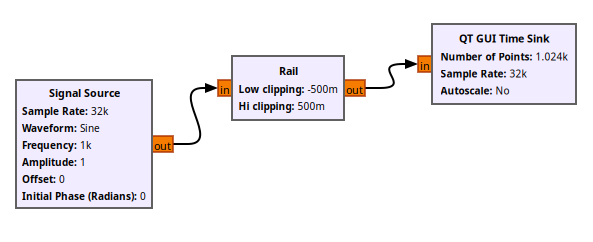Rail: Difference between revisions
Jump to navigation
Jump to search
(The **Rail** block in GNU Radio clips an input signal to a specified range by setting values below a low threshold to that minimum and values above a high threshold to that maximum, with both thresholds being run-time adjustable. Values within the range remain unchanged.) |
No edit summary |
||
| Line 18: | Line 18: | ||
; C++ files | ; C++ files | ||
: [https://github.com/gnuradio/gnuradio | : [https://github.com/gnuradio/gnuradio/blob/main/gr-analog/lib/rail_ff_impl.cc] | ||
; Header files | ; Header files | ||
: [https://github.com/gnuradio/gnuradio | : [https://github.com/gnuradio/gnuradio/blob/main/gr-analog/lib/rail_ff_impl.h] | ||
; Public header files | ; Public header files | ||
: [https://github.com/gnuradio/gnuradio | : [https://github.com/gnuradio/gnuradio/blob/main/gr-analog/include/gnuradio/analog/rail_ff.h] | ||
; Block definition | ; Block definition | ||
: [https://github.com/gnuradio/gnuradio TODO] | : [https://github.com/gnuradio/gnuradio TODO] | ||
Latest revision as of 12:13, 28 April 2025
Clips input values that go below a minimum or above a maximum.
Parameters
(R): Run-time adjustable
- Low clipping (R)
- The low value to clip to.
- High clipping (R)
- The high value to clip to.
Example Flowgraph
This flowgraph can be downloaded from Media:RAIL.grc.
Source Files
- C++ files
- [1]
- Header files
- [2]
- Public header files
- [3]
- Block definition
- TODO
